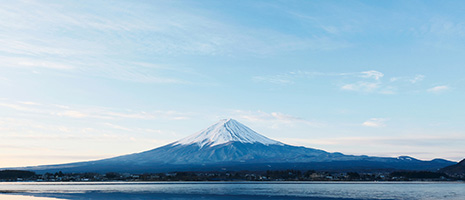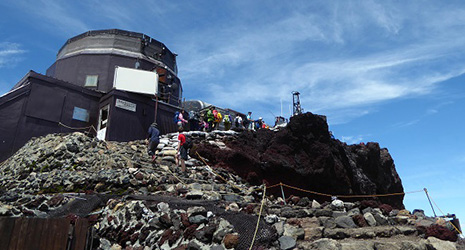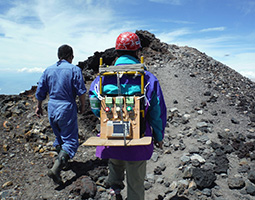Home > Highlighting JAPAN > Highlighting Japan January 2018 > Science & Technology
Highlighting JAPAN


Research at the Top of Mount Fuji
Superseded by weather satellites and temporarily left unmanned, Mount Fuji Weather Station is back in operation as a non-profit organization (NPO), attracting researchers every summer from Japan and overseas.
Weather observation has been conducted for many years on the top of Mount Fuji, which is 3,776 meters above sea level. In 1932, a weather observation facility fully utilizing Japan’s highest point was launched. In that year, the Temporary Weather Station of the Central Meteorological Observatory (the current Japan Meteorological Agency) was established, and all-season weather observation commenced. In 1964, a weather radar called the Mount Fuji Radar System, which was capable of observing a radius of 800 kilometers, was constructed on top of Mount Fuji, and Japanese weather observation for typhoon forecasts made a significant leap forward. After weather satellites began to be operated in the 1970s, however, the role of Mount Fuji Weather Station gradually declined. In 1999, the Radar System stopped its operation. In 2004, it was decided that Mount Fuji Weather Station would be unmanned, leaving the Automated Meteorological Data Acquisition System (AMeDAS).
Many people were disappointed by the closure of the station and hoped that it would continue to be utilized. In response, the certified NPO Mount Fuji Research Station (MFRS)1 was founded in 2005.
Kazuhiko Miura, Chief of the Secretariat of MFRS and a professor at the Faculty of Science of Tokyo University of Science, says of the importance of Mount Fuji Research Station, “For Mount Fuji, which is an independent mountain, about half of its mountain form is in the free troposphere2. That is, Mount Fuji is a location where you can directly observe the air that is not affected by human activities on flat land. It is an essential observation facility for conducting research on global warming and trans-boundary air pollution.”
MFRS rents part of the facilities of what used to be Mount Fuji Weather Station from the Japan Meteorological Agency, and has conducted summer observations from July to August every year since 2007. Every year, between 400 and 500 researchers stay on top of Mount Fuji, among them members of research groups from Taiwan, France and Germany. The MFRS works on a wide range of areas, such as electric discharge caused by thunderclouds, the measurement of cosmic rays3, the monitoring of permafrost4 and research on medicine and training in high places as well as observation and research of the air on Mount Fuji.
To undertake research into the effects of aerosols (minute particles) on climate change, new particle formation in the free troposphere, their growth into cloud condensation nuclei5 and the processes of clouds emerging, Miura measured aerosols and cloud particles on top of Mount Fuji. The period for observation from 2006 to 2016 totaled 300 days in the summer months. The event of new particle formation where the density of particles of 25 nm and under was high was observed 236 times. This event was observed 142 times in the nighttime, compared with 94 times in the daytime. This phenomenon cannot be seen on the Jungfraujoch in the European Alps, the Himalaya Mountains or the Rocky Mountains, and is speculated to be unique to Mount Fuji.
The summit of Mount Fuji has extremely low air pressure and low temperatures compared with flat land. It is a facility that is exposed to a tough environment, including strong winds and intense direct sunshine, which is challenging for researchers.
Yukiko Dokiya, Emeritus Professor at Edogawa University, who is the Director of the MFRS, says, “We see numerous problems every year. Researchers suffer from mountain sickness. Power lines are damaged and cut by snow and construction errors. Our biggest issue is maintenance expenses for a facility that costs 30 to 40 million yen (260,000 to 355,000 US dollars) per year for a stay on the summit of Mount Fuji for two months in summer. In addition, Mount Fuji is part of a national park designated as a World Heritage site, we have to bring toilet waste down to the foot of the mountain. If Mount Fuji Research Station is abolished, however, we will never be able to build a similar facility. It is extremely important to maintain and manage the facility for many years, utilizing the current facility.”
The MFRS is committed to establishing an all-season observation structure and aims to share data it has gathered in high observatories all over the world through networks. If researchers all over the world can share information, they will be able to further heighten the accuracy of observation in high places and utilize it for measures for global environmental preservation. Both Miura and Dokiya say, “The summit of Mount Fuji is a land of treasures for researchers.”
In terms of results, there have been 57 refereed academic papers and more than 500 academic presentations since the first summer observation in 2007. On the basis of them, during the week of November 6–10, 2017, MFRS hosted the third international symposium on “Atmospheric Chemistry and Physics at Mountain Sites” in Gotemba, Shizuoka Prefecture, in which 76 leading atmospheric scientists from 12 countries and 1 region around the world shared their research results. From the data presented, it became clear that high elevation mountain atmospheric observatories provide a unique window on long range transport of air pollution, chemical reactions in the atmosphere, and crucial information on background concentrations of trace gases and aerosols.
Mount Fuji Research Station attracts a lot of attention as an arena for education and developing researchers as well as being a research facility. MFRS is spreading its wings to the future, just as Mount Fuji extends from the summit.
Note
1 Mount Fuji Research Station (MFRS) changed its English name in January 2016 from NPO Valid Utilization of Mt. Fuji Weather Station.
2 The part that is close to the surface of the atmospheric layer that surrounds the earth and that is influenced by the ground and sea level is called the atmospheric boundary layer (about 1,000 meters). The part up to the tropopause that is above it (about 10,000 meters) is called the free troposphere.
3 Cosmic rays are atomic nuclei and elementary particles that pour constantly at high speed from the universe to the earth.
4 Permafrost is land whose underground temperature is below 0 degrees throughout the year and that remains frozen for more than two years.
5 Cloud condensation nuclei are minute particles on which water vapor condenses.
© 2009 Cabinet Office, Government of Japan







